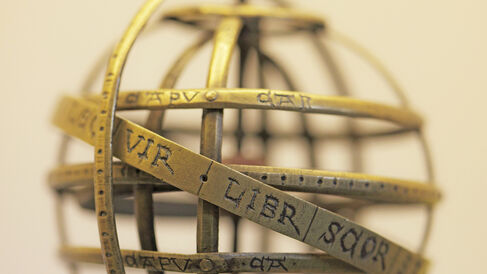Armillary Spheres and Teaching Astronomy

Armillary spheres are models of the universe. They have been used since antiquity, but very few survive from before the 16th century. The Whipple Museum has one very early example, though dating it accurately is extremely difficult.
Some armillary spheres were used for observing the heavens and some, like this one, were used for teaching and demonstration (Image 1). They are made up of the circles or rings (Latin: armillae) that are used by astronomers to describe the night sky. The names of some of these circles might be familiar to non-astronomers because they are also used to divide up the globe: the arctic and antarctic circles; the Tropics of Cancer and Capricorn, and the equator.
An astronomical compendium (plural = compendia) is an instrument that carry numerous devices for telling the time and performing astronomical calculations. Many compendia were made in the German lands in the late 16th and early 17th centuries. They are often beautifully engraved in gilt brass. Typically such compendia carry a sundial, various lunar and solar volvelles, a compass, tables of latitude, and a perpetual calendar.
These two different types of telescope date from a similar time period and were made by important instrument makers. They differ in their methods of focusing distant light from the stars: one uses lenses to refract (bend) incoming light, the other has mirrors to reflect light.
Low survival rates
Historians disagree about the origin and the use of demonstrational armillary spheres, partly because the available evidence is difficult to interpret.
Very few examples of the instrument survive from earlier than the 16th century. This may be due to their fragile nature and the materials used to construct them. Delicate spheres composed of rings, even when these were made of brass, are less likely to have been preserved than flat instruments such as astrolabes.
While there is a good deal of evidence suggesting that ancient and medieval armillary spheres existed, much of it is not straightforward. Medieval texts often refer to instruments that could be either armillary spheres or celestial globes. Texts that specifically mention the construction and use of armillary spheres seem to be less common than those that deal with other astronomical instruments.
Spheres and globes
It seems likely that the uses of demonstrational and observational armillary spheres were closely related. Ancient astronomers such as Claudius Ptolemy and medieval scholars working within the Islamic world wrote about observational armillary spheres that were larger than demonstrational ones. Demonstrational armillaries were clearly known in Western Europe from the later Middle Ages onwards, and were commercially produced in the 16th, 17th and 18th centuries. Like globes, they are still produced as ornaments for the home, as garden furniture, and as monuments.
A handheld armillary
This demonstrational armillary sphere (Image 1) from the Whipple collection is difficult to date. Nothing is known of its history or provenance other than that it was purchased by Robert Whipple in a London shop in 1928. It seems quite likely that the wooden stand was made within the last two hundred years. When originally produced, the instrument was probably designed to be held by a handle extending from the southern pole. Whilst this type often is seen in medieval and early-modern illustrations, it was rarely constructed (Image 2).
The difficulties of dating the instrument
For most of the second half of the 20th century this object was described by the Whipple Museum as having been made in about 1450. This would make it one of the earliest surviving demonstrational armillaries. Two other armillary spheres held in other museums date from this period, however this object is rather different from both of these. It is very difficult to date the armillary using the style of the lettering. The letter-shapes used to label the rings of the sphere suggest that it may have been produced at an even earlier date: perhaps in the 14th century.
An armillary sphere such as this one might well have been used for education, aiding understanding of the 3-dimensional geometry of the celestial sphere. This makes sense, as many medieval and early-modern texts in basic astronomy refer to or assume the use of armillaries as models of the heavens. Medieval illustrations even suggest that a 3-dimensional visual aid might well have been a necessary companion to texts on the celestial sphere, such as the 13th-century De sphaera by Sacrobosco, which was a widely used university textbook.
Adam Mosley, 'Armillary spheres and teaching astronomy', Explore Whipple Collections, Whipple Museum of the History of Science, University of Cambridge, 2006
